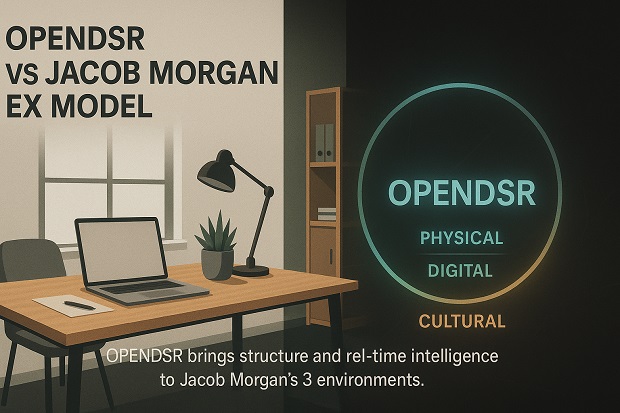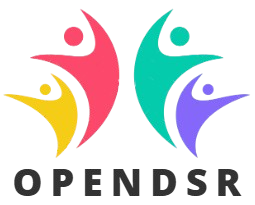
Jacob Morgan’s 3 Environments vs OPENDSR: Designing Harmony
Jacob Morgan’s 3 Environments vs OPENDSR: Designing Harmony How OPENDSR brings structure and real-time intelligence to Jacob Morgan’s three environments of employee experience. Introduction: From Workplace Design to Experience Intelligence
In the last decade, Jacob Morgan’s “Three Environments of Employee Experience” has reshaped how organizations perceive the modern workplace. His model — encompassing Physical, Technological, and Cultural environments — reframed employee experience (EX) as a holistic ecosystem rather than a set of disconnected HR practices.
Yet, as organizations grow more dynamic and digital-first, the challenge has evolved: How do we move beyond designing environments to orchestrating real-time, adaptive experiences?
Enter OPENDSR, a human-centered EX operating system that transforms these three environments into live, data-driven, empathetic ecosystems. Where Morgan’s model defines what matters, OPENDSR defines how to activate and sustain it.
1. Revisiting Jacob Morgan’s 3 EnvironmentsJacob Morgan’s framework asserts that every employee experience is shaped by three interconnected domains:
Environment Definition Focus Areas Physical The tangible spaces where employees work — offices, facilities, design, safety, ergonomics. Workspace design, health, accessibility Technological The tools and platforms that enable productivity and connection. Systems integration, digital tools, automation Cultural The emotional and social fabric that binds the organization together. Leadership trust, values, inclusion, belongingMorgan’s core argument is that EX success depends on the intersection of these environments — where the physical supports well-being, technology enables ease, and culture fuels engagement.
However, as digital transformation accelerates, static environment design no longer suffices. Organizations now need continuous sensing, feedback loops, and real-time improvements — precisely where OPENDSR steps in.
2. The OPENDSR Approach: From Framework to Operating SystemOPENDSR (Observe, Prioritize, Envision, Navigate, Design, Systematize, Refine) is more than a framework; it’s a human-centered EX operating system.
It bridges organizational design, experience measurement, and behavioral science, helping leaders turn insight into ongoing improvement.
Step Action Impact on EX Observe Capture real-time signals from employees and operations. Replace annual surveys with continuous sensing. Prioritize Identify what truly matters across physical, digital, and cultural domains. Focus energy where it creates impact. Envision Co-design desired future experiences. Align leaders, HR, and employees. Navigate Map transition paths and quick wins. Manage change empathetically. Design Build prototypes and interventions. Test EX ideas safely. Systematize Scale what works across teams. Institutionalize culture and consistency. Refine Measure, learn, and adapt continuously. Sustain momentum through insight.This cycle complements Morgan’s 3 Environments by providing the real-time engine those environments need to stay alive and evolving.
3. Comparative Overview: Morgan vs OPENDSR Dimension Jacob Morgan’s 3 Environments OPENDSR Core Difference Philosophy Create great places to work through environmental design. Enable adaptive, data-driven, human experiences. OPENDSR adds live intelligence to environment design. Focus Physical, Technological, and Cultural harmony. Observation, Prioritization, and Continuous Refinement. From static design → dynamic iteration. Measurement Observational and survey-driven. Real-time feedback, dashboards, and behavioral data. From reflection → action. Implementation Model Conceptual framework. Operational system (7-step process). From theory → repeatable practice. Outcome Improved engagement and retention. Continuous EX evolution and adaptability. From engagement → resilience. 4. How OPENDSR Activates the Three EnvironmentsLet’s see how OPENDSR embeds real-time feedback and design intelligence into each of Morgan’s environments:
A. Physical Environment → Observe + DesignMorgan emphasized space as a driver of comfort and creativity. OPENDSR extends this by turning space data — occupancy, flow, sentiment — into insights for human-centered design.
Example:
-
Morgan’s model: “Create open spaces to foster collaboration.”
-
OPENDSR: “Measure collaboration heatmaps and adjust physical layouts monthly.”
Morgan saw technology as the great enabler. OPENDSR treats it as a living nervous system, where tools learn and adapt through data.
Example:
-
Morgan’s model: “Provide seamless technology.”
-
OPENDSR: “Continuously learn from system interactions to predict friction and recommend simplifications.”
Morgan defined culture as the invisible force shaping belonging and purpose. OPENDSR turns that into a measurable, adaptive culture loop.
Example:
-
Morgan’s model: “Foster a culture of trust and inclusion.”
-
OPENDSR: “Detect trust trends through sentiment analysis and real-time feedback, triggering leadership action loops.”
Morgan’s model revolutionized EX by broadening it beyond HR functions. However, organizations now operate in volatile, hybrid, and emotionally complex realities.
Today’s EX challenge:
How can we ensure the physical, digital, and cultural are continuously harmonized — not just designed once and forgotten?
OPENDSR’s contribution:
By introducing feedback intelligence, empathetic design, and systemized iteration, it bridges the gap between insight and impact.
-
Before (Jacob Morgan’s Model):
The organization redesigned its offices with flexible seating, rolled out collaboration tools, and hosted quarterly culture sessions. -
Outcome:
Engagement improved temporarily, but fatigue and disconnect re-emerged post-rollout. -
After (OPENDSR Integration):
Through Observe and Refine cycles, the organization continuously tracked employee sentiment on space usage, digital friction, and leadership empathy. Real-time dashboards guided interventions weekly, not annually.
Jacob Morgan inspired leaders to design better workplaces. OPENDSR encourages them to listen, learn, and adapt continuously.
Philosophical Axis Morgan’s 3 Environments OPENDSR Design Intent Build harmony among environments Create adaptive harmony through feedback loops Leadership Role Vision and culture-setting Co-designing and sensing in real-time Employee Role Participant Co-creator and signal generator Technology Role Enabler Intelligent connector and listener 8. Table of Key Differentiators Aspect Jacob Morgan’s Model OPENDSR Core Aim Harmonize work environments Operationalize human experience through data Methodology Conceptual and design-based Empathy-led, data-informed cycle Feedback Loop Periodic Continuous Scope Workplace design End-to-end experience system Data Source Surveys and interviews Behavioral, sentiment, and workflow data Outcome Engagement uplift Adaptive culture evolution 9. Why This Comparison Matters NowThe workplace has shifted from place to presence. The line between physical, digital, and emotional experience has blurred — and organizations must evolve to sense and respond faster than ever.
Morgan’s model remains the foundation — a brilliant articulation of what great experiences look like.
OPENDSR is the next layer — the operating rhythm that keeps those experiences alive.
Together, they represent the evolution of EX thinking: from environmental design to adaptive orchestration.
10. Conclusion: Designing Harmony Through IntelligenceJacob Morgan gave organizations a map of what great experience environments look like. OPENDSR provides the compass and navigation system that keeps the journey on track.
The synthesis of the two models marks a new era:
-
Where culture isn’t a static value, but a real-time emotion.
-
Where technology doesn’t just support work, but listens and adapts.
-
And where leadership isn’t about managing change, but co-designing human evolution.
As organizations mature, the question is no longer “What environment are we creating?” — it’s “How intelligently are we evolving it?”
And in that answer lies the future of work — one that is designed, refined, and human at its core.








